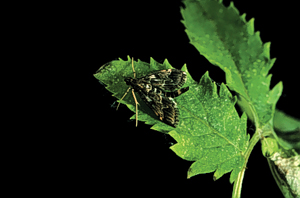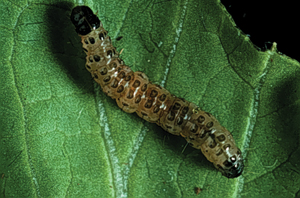
Features
Crop Protection
Inputs
An overview of Duponchelia control options
November 11, 2008 By Graeme Murphy
Duponchelia fovealis is a
relatively new pest in Ontario, and as such there is little experience
in knowing what to expect if it shows up in your greenhouse and how to
control it if it does. It is worthwhile to quickly review what we know
of this pest.
A moth of Mediterranean origin,it is a relatively new pest in Ontario
 |
| Figure 1. Duponchelia adult. |
Duponchelia fovealis is a relatively new pest in Ontario, and as such there is little experience in knowing what to expect if it shows up in your greenhouse and how to control it if it does. It is worthwhile to quickly review what we know of this pest.
Duponchelia is a moth of Mediterranean origin, which first showed up in northern European greenhouses about 20 years ago, and has since become well established as a greenhouse pest in that region. It was first found in Ontario in 2005 and more recently during the winter of 2007-2008. It is a small (approx. 1 cm long) moth, light brown in colour with a white irregular line across the wings. It has a very long pointed abdomen, which is turned up at the end, almost at right angles.
IF LEFT UNCONTROLLED, IT CAN CAUSE SIGNIFICANT DAMAGE
 |
| Figure 2. Duponchelia caterpillar. |
From a damage perspective, if left uncontrolled, this pest is capable of causing significant damage in some crops (e.g., begonia) where it can feed on the lower leaves and tunnel into the stem of the plant. In others (e.g., roses), quite large populations do not result in much actual crop damage, as the caterpillars seem to feed mainly on leaf litter on the soil surface.
However, in most Ontario greenhouses where it has been found, actual crop damage has been minimal. It seems to live quite well on dead organic matter in or on the soil, which means it can survive in many different crops.
Often the caterpillar spins a fairly untidy web low down in the plant and it will stay within that web during the day. In other situations it can be found in the soil or down between the edge of the pot and the growing medium, or even underneath the pot. The adult moth is nocturnal, but is easily disturbed in the day and will make short erratic flights, although even when you see it land, it can still be hard to find.
So, if you find Duponchelia in your greenhouse, what are the options? As far as control is concerned, a diligent control program should be able to maintain pest populations at very low levels. Both pesticide and biological control can work quite effectively.
THREE PESTICIDES HAVE RECEIVED MINOR USE REGISTRATIONS
In the early part of this year, a number of pesticides were registered under the Emergency Use program of the Pest Management Regulatory Agency. These included DDVP Smoke Fumigators, and Pounce 384 EC for control of adults, and Dipel 2X DF for control of caterpillars. Emergency uses are for a limited period of time only, and the recurring (and likely ongoing) nature of this pest meant that more permanent registration of products was needed. As such, applications were submitted for full registration of three products (Pounce, Dipel and BioProtec 3P) under the Minor Use Program. BioProtec 3P contains the same active ingredient as Dipel and is active against the caterpillar. These registrations have been approved.
It should be noted DDVP does not have full registration and its Emergency Use label for control of Duponchelia adults is only valid until Dec. 28, 2008 (although it will still be registered after that for other greenhouse uses). The above pesticides will provide good control of Duponchelia although it will require repeated applications.
EUROPEAN RESEARCH SUGGESTS BIOCONTROL CAN BE EFFECTIVE
Research from Europe suggests that biological control can be very effective in controlling this pest and there are a number of options available. The two larval pesticides, Dipel and BioProtec, are biological in origin and fully compatible with biocontrol. As a regular foliar and soil surface spray, they remain an important component of Duponchelia control and in fact form the basis of control programs in European countries as well. It should be noted, however, that Pounce and DDVP for adult control are incompatible with biocontrol programs. Pounce applications will result in residues that preclude the use of biocontrol programs for up to three months.
Other biocontrol agents are also effective. The moth often lays its eggs on plant parts close to the soil, and the caterpillars spend most of their life in the lower part of the plant or on the soil surface. As a result, soil-dwelling biocontrol agents can be very useful. Dutch research has shown that the predatory mite Hypoaspis and the rove beetle Atheta (which are already used by many growers) can offer quite effective control. There is some suggestion that nematode drenches (or soil surface sprays) can also be useful, but even if they’re not, they will still be useful for control of pests such as fungus gnats.
There are other biocontrol agents that have been shown to feed on moths/caterpillars (or their eggs), although there is little research at this stage to show whether they would be specifically effective in controlling Duponchelia. For example, Orius will feed on moth eggs, as will a tiny parasitic wasp called Trichogramma. A predatory bug called Podisus preys on caterpillar larvae. Some growers have introduced these natural enemies as a precautionary measure against Duponchelia, but remember that these particular biocontrols have not been proven for this pest.
NO BIOCONTROL AGENTS YET FOR CONTROL OF ADULT STAGE
As far as adults are concerned, there are no biocontrol agents available. However, there are traps that will catch adults although it is unclear as to whether they can offer significant control. Even so, they can still serve a very useful purpose as a monitoring tool and a check on how well control programs are working. There is a specific sex pheromone that attracts male Duponchelia and traps using this technology are available. Likewise, black light traps (UV light) will attract adults (male and female) although not as effectively as the pheromone traps. Be careful when using adult traps. If the vents are open, moths can be attracted from outside, so these tools are more suitable during the cooler months.
To summarize, a biocontrol program should consist of:
• Weekly Dipel or BioProtec sprays to the lower foliage and soil surface.
• Use of soil-dwelling predators such as Hypoaspis and/or Atheta.
• Possibly nematode sprays to the soil surface.
• Pheromone or UV light traps for adult monitoring.
It is important that growers understand this pest, monitor for its presence and have a control plan prepared if they find it. Despite its impact on the industry earlier this year, there is no need to panic if it is found now. Effective strategies are available that should ensure good, ongoing control. To discuss further, contact an OMAFRA greenhouse specialist.
Graeme Murphy is the greenhouse floriculture IPM specialist with the Ontario Ministry of Agriculture, Food and Rural Affairs at Vineland.
• 905-562-4141, ext. 106, or graeme.murphy@ontario.ca
Print this page